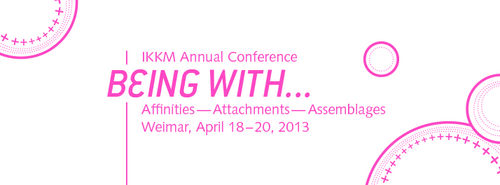IKKM Annual Conference »Being with ...«
The IKKM extends an invitation to its annual conference at the Congress Centre Neue Weimar Halle from 18- 20 April 2013. 18 international presenters and Respondents ask how new social aspects are understood and described as a gathering of things and people.
IKKM Annual Conference »Being with ...
Affinities - Attachments - Assemblages«
18. bis 20. April 2013
Conventionally a place of assembly means a place where people come together. Town squares, pubs, stadiums, and parliaments are all examples of places whose physical construction and layout predetermine the conditions and rules governing who can assemble there and what activities are possible. If one extends the capacity for assembly from people to objects, then other places will also fall within the definition of a place of assembly: a museum, for example, or a collection of any kind; but likewise, a writer's desk, or even fictive places such as a still life painting. Assemblies are further characterized by their unique relation to time – they are always based on processes of synchronization that bring together people, objects and activities, not merely through the synchronization of temporal present(s), but also by preserving the past (as in the case of the museum) and by stabilizing the future (in the case of the parliament).
The conference will examine assemblages and synchronizations of people and objects. Yet it shifts the focus to the actions and operations, which constitute them in the first place. In this sense, places of assembly do not precede the activities that occur in them, but are rather produced through the linking and networking of operations and their synchronization. This examination of actions and operations inverts the traditional concept of place by shifting the focus from places of assembly as already predetermined places to the processes of 'becoming place'. Consequently, notions of place primarily defined by the drawing of boundaries (e.g. the distinction between inside and outside) are challenged by the (open) processes of joining, decoupling and rejoining and the various relations to time they entail.
"Being with" aims to explore the bonding forces of assemblies and their different stages or intensities of cohesion. The spectrum ranges from an open, continuously adjustable 'throwntogetherness' (Doreen Massey), to the fragile processes of inclination, affinity, and attachement (Antoine Hennion), to dense structures of affecting, organizing, and distributing (Nigel Thrift) or force fields of assembly and networks of operations, which in recent years have been increasingly discussed in terms of assemblages (Jane Bennett, Manuel DeLanda and others, building on Deleuze/Guattari). Assembly places thus only come into being in the course of a complex process of negotiation, which complicates the distinction between human and nonhuman actors; between active and passive. "Being with" studies networks of distributed actions and seeks to assess the potential of places of assembly as open ensembles of couplings, affinities, and attachments.
The Internet and social networks organize the linkages and boundaries of globally distributed people and objects, as recently demonstrated by Anonymous, Occupy Wall Street, and the revolutions in North Africa. At the same time they concentrate the representation of their linkages in the few places where such relationships are created, calculated, and stored. The monitoring and representation of these assembly infrastructures, of their potentials for bonding and dividing, and of their role in radical new social developments, are all major arenas in and about which the debate on assembly practices and their infrastructures takes place. These newly arising mobile assembly places and assemblies also maintain a special relationship with time – it is here that the formations of present, past, and future are negotiated, and where the resources are mobilized that will keep the world round or program it for change.
The IKKM annual conference will examine the processes of formation, stabilization, and dissolution of assemblies. How can we describe assembly places as open ensembles of bondings and linkages? How does an actor-network achieve its (temporary) stabilization? How do operations of synchronization affect this process? And how is one to define fragile assembly types that never achieve a state of stability? This raises the question of how the exploration of the forms and conditions of "Being with" can be understood as symptoms of our time. In the face of a continual emergence of new assembly types, the traditional concept of place shifts towards a mobile, perpetually migrating, and ephemeral infrastructure of assembly places, asking for a new spatial vocabulary of mutual couplings, affinities, and attachments.
The conference language is English.
For further information please visit: www.ikkm-weimar.de

